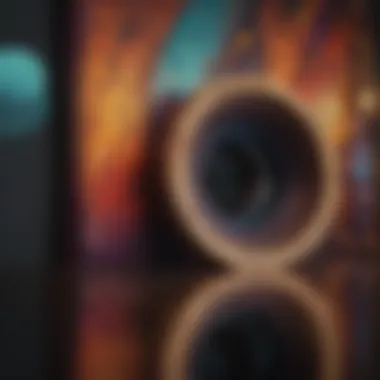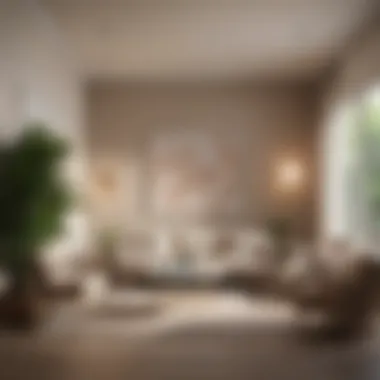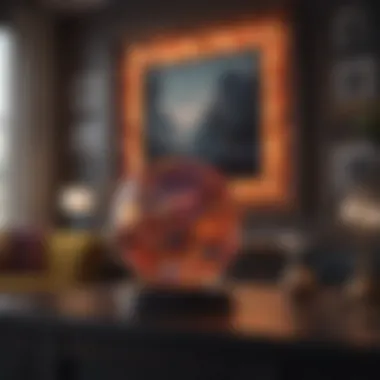Unveiling the Influence of Colors on Home Interior Design: A Comprehensive Analysis


Outdoor Decor Ideas
Color plays a pivotal role in home interior design, influencing the ambiance, style, and functionality of living spaces. It is essential to understand how different color schemes can transform a room from feel dark and cramped to open and welcoming. Psychological studies have shown that colors have a profound impact on human emotions and behaviors. For instance, blues and greens are known for their calming effects, making them ideal for bedrooms or relaxation areas. On the other hand, vibrant reds and yellows can stimulate energy and creativity, perfect for workspaces or areas where active engagement is desired. When selecting colors for a room, it's crucial to consider the room's purpose and the desired mood.
Seasonal Inspirations
Choosing color schemes based on seasonal inspirations can breathe new life into your home decor. For example, during the spring season, pastel colors like light pinks, soft yellows, and mint greens can evoke feelings of freshness and renewal. In contrast, warm earth tones such as deep oranges, browns, and golds can depict the cozy warmth of fall and winter. By incorporating seasonal colors into your home, you can create a dynamic and ever-changing environment that reflects the spirit of each season.
Furniture Selection
Color can significantly impact the appearance of furniture in a room. Dark-colored furniture pieces can create a sense of sophistication and opulence, while lighter shades can make a space feel airier and more expansive. When choosing furniture colors, it's essential to consider the overall color scheme of the room to ensure cohesion and balance. Additionally, incorporating accent pieces in bold or complementary colors can add visual interest and personality to the space.
Decorative Lighting
Lighting plays a crucial role in showcasing the colors in a room. Natural light can enhance the vibrancy of colors, while artificial lighting can be used to create ambiance and highlight specific areas. Choosing the right lighting fixtures and bulbs can impact how colors are perceived, making it essential to consider factors such as color temperature and intensity. By strategically placing lighting sources, you can accentuate the colors in your home and create the desired atmosphere.
Plant Arrangement
Plants not only add a touch of nature to a space but also bring color and texture into the design. Green plants can provide a refreshing burst of color, while flowering plants can introduce vibrant hues that brighten up a room. When arranging plants, consider the color of their leaves and blooms to complement the existing color palette. Additionally, incorporating planters in different finishes and colors can act as decorative elements that tie the room together.
Hardscaping Solutions
In outdoor spaces, hardscaping elements such as stone pathways, retaining walls, and patio surfaces play a significant role in the overall design. The color of hardscaping materials can influence the visual impact of the outdoor area, creating a cohesive look that complements the surrounding landscape. When selecting hardscaping materials, consider coordinating colors with existing architectural features or natural surroundings to achieve a harmonious aesthetic.
Sustainable Practices
Incorporating sustainable practices into home design can extend to the use of eco-friendly paint colors and materials. Opting for low-VOC or natural paints not only reduces harmful emissions but also promotes a healthy indoor environment. Additionally, choosing sustainable materials such as recycled glass countertops or reclaimed wood furniture can add unique colors and textures to your space while minimizing environmental impact. By embracing sustainable practices, you can create a colorful and socially responsible home interior that reflects your commitment to a greener lifestyle.
Introduction


In the realm of home interior design, color stands as a paramount element that can elevate the ambiance, style, and functionality of living spaces significantly. This article embarks on a profound exploration of color's impact on interior design, unraveling the nuanced ways in which different color schemes intertwine with the essence of our homes. By delving into the intricate relationship between color and design, readers will unearth the transformative power colors hold in shaping the character of living environments.
Understanding the Significance of Color in Home Interior Design
The Intersection of Psychology and Design
The fusion of psychology and design marks a pivotal juncture in the realm of home interior aesthetics. By delving into the confluence of these disciplines, we unveil how human cognition and emotion intertwine with visual elements to influence our perceptions of space and design. This synergistic blend offers a deeper comprehension of the psychological underpinnings behind color selection and placement within interiors, highlighting the profound influence of colors on our mood and well-being. The adoption of psychological principles in design not only enhances the aesthetic appeal of spaces but also fosters a harmonious alignment between visual stimuli and emotional resonance, making it a compelling choice in crafting captivating home interiors. Integrating psychological insights into design decisions empowers individuals to curate living spaces that resonate with their innate needs and desires, forging a profound connection between inhabitant and habitat.
Impact of Color on Mood and Perception
Colors wield a potent influence on our mood and perception, shaping how we experience and interact with our surroundings on a subconscious level. The impact of colors on our emotional well-being and cognitive processes underscores their pivotal role in interior design. By leveraging specific color palettes, designers can evoke a diverse range of emotions and sensations within a space, ranging from tranquility and serenity to energy and passion. This nuanced manipulation of color psychology enables designers to craft dynamic narratives within interiors, eliciting varied responses from occupants based on color choices. While colors imbue spaces with vibrancy and character, they also pose challenges in terms of achieving optimal balance and coordination. Balancing the emotional resonance of colors with the intended ambiance of a space demands a keen understanding of color psychology, ensuring that the design exudes coherence and charm while resonating with the inherent essence of the space.
Psychological Effects of Colors
Color plays a crucial role in home interior design, influencing the ambiance, style, and functionality of living spaces. Understanding the psychological effects of colors is key to creating a harmonious environment that resonates with the inhabitants. By choosing the right color schemes, one can evoke specific moods and perceptions within a room, shaping the overall experience of the space.
Warm vs. Cool Tones
Emotional Response to Warm Colors
Warm colors like reds, oranges, and yellows evoke feelings of energy, passion, and enthusiasm. These hues are known to create a sense of warmth and intimacy, making them popular choices for living rooms and dining areas. The bold and vibrant nature of warm colors can add a lively touch to any space, instilling a sense of dynamic vibrancy and creativity.
Calmness and Serenity with Cool Colors
On the other hand, cool tones such as blues, greens, and purples are associated with tranquility, serenity, and calmness. Cool colors have a soothing effect on the mind, making them ideal for bedrooms, offices, and relaxation areas. Their ability to instill a sense of peace and harmony contributes to creating a serene and relaxing atmosphere within a room.
Color Associations in Interior Design
Red for Energy and Passion


The color red is synonymous with energy, passion, and excitement. In interior design, red is often used to create a focal point, drawing attention and infusing a space with a sense of vitality. When strategically incorporated, red accents can add depth and drama to a room, making it a bold choice for those looking to make a statement.
Blue for Tranquility and Trust
Blue hues are associated with tranquility, trust, and dependability. In home interiors, blue conveys a sense of calmness and reliability, making it a popular choice for bedrooms and relaxation areas. The versatility of blue allows for the creation of serene, elegant spaces that promote a feeling of security and tranquility.
Choosing the Right Color Palette
In the realm of home interior design, the selection of a color palette plays a pivotal role in defining the visual atmosphere and character of a space. Choosing the right colors is akin to orchestrating a symphony, where each hue harmonizes with the others to create a cohesive and aesthetically pleasing composition. A carefully curated color palette not only enhances the overall vibe of a room but also influences the mood and perception of its occupants. By strategically combining different shades, tones, and tints, designers can evoke specific emotions and lend functionality to different areas within a home. The process of selecting the right color palette involves a thoughtful consideration of factors such as natural light exposure, room size, furniture, and personal preferences to ensure a harmonious and stylish interior.
Harmonizing Colors for Cohesive Design
Complementary and Analogous Color Schemes
Within the context of interior design, the utilization of complementary and analogous color schemes is fundamental for achieving visual harmony and impact. Complementary color schemes, comprising colors located opposite each other on the color wheel, create a striking contrast that can breathe life into a room. This juxtaposition of hues adds a dynamic and energetic touch to interiors, making them visually engaging and stimulating. Analogous color schemes, on the other hand, involve selecting hues that are adjacent to each other on the color wheel. These schemes offer a more subtle and cohesive aesthetic, where colors blend harmoniously to produce a serene and balanced environment. By employing complementary and analogous color schemes effectively, designers can infuse rooms with vibrancy or sophistication, catering to varying preferences and design goals.
Creating Visual Balance with Neutrals
In the realm of interior design, neutrals serve as the unsung heroes that anchor a space and provide a sense of balance and versatility. Neutrals, such as whites, beiges, and grays, act as the perfect backdrop for bolder colors to shine while also imparting a feeling of calm and sophistication. By incorporating neutrals into a color palette, designers can prevent overwhelming visual stimuli and ensure a cohesive and well-coordinated decor. Neutrals offer a timeless appeal, allowing for flexibility in accentuating different design elements and aesthetics. Whether used as a primary color or as accents, neutrals contribute to creating visual equilibrium and elegance in interior spaces, transcending trends and fads for enduring style and refinement.
Personalizing Spaces with Accent Colors
Strategic Use of Bold Colors
Bold colors serve as potent tools for injecting personality and drama into home interiors, making a bold design statement and reflecting the homeowner's unique taste and style. Strategic placement of bold hues, such as vibrant reds, deep blues, or rich greens, can evoke strong emotions and create focal points within a room. Bold colors can be used sparingly to draw attention to specific architectural features, furniture pieces, or decor items, infusing spaces with energy and flair. While bold colors add excitement and character to an interior, their strategic incorporation is crucial to maintaining visual balance and preventing sensory overload. When employed judiciously, bold colors amplify the visual impact of a room, transforming it into a captivating and stimulating environment.
Adding Depth with Monochromatic Schemes
Monochromatic color schemes offer a sophisticated and sleek approach to interior design, leveraging varying shades and tones of a single color to create depth and dimension. By sticking to one dominant hue and playing with its lighter and darker variations, designers can achieve a sense of understated elegance and cohesion in a space. Monochromatic schemes promote visual continuity and a sense of expansiveness, ideal for smaller rooms or areas where a tranquil and cohesive ambience is desired. The subtlety of monochromatic palettes allows for a focus on textures, patterns, and forms, elevating the overall aesthetic without overwhelming the senses. When executed thoughtfully, monochromatic schemes can impart a sense of luxury and refinement to home interiors, showcasing a nuanced understanding of color and design principles.


Practical Tips for Color Implementation
As we delve into the intricate world of home interior design, the section on Practical Tips for Color Implementation holds significant importance. This segment serves as a guiding beacon for individuals seeking to harness the power of color in transforming living spaces. By offering detailed insights and recommendations, this section aims to equip readers with the necessary knowledge to make informed decisions regarding color choices within their homes. Exploring Practical Tips for Color Implementation not only enhances the aesthetic appeal of a space but also plays a pivotal role in creating a harmonious and inviting environment for residents and guests.
Natural Light and Color Dynamics
Optimizing Natural Light for Color Clarity
Within the realm of home interior design, Optimizing Natural Light for Color Clarity stands out as a crucial aspect. This practice entails strategically utilizing natural light sources to accentuate the hues present in a room. By doing so, it enhances the vibrancy and clarity of colors, thus elevating the overall visual appeal of the space. Opting for this approach guarantees that colors appear true to their essence, creating a dynamic and inviting atmosphere. The prominence of Optimizing Natural Light for Color Clarity in this article reflects its proven ability to optimize the visual impact of color schemes within home interiors.
Adapting Colors to Room Orientation
Adapting Colors to Room Orientation is another fundamental consideration in the realm of home interior design. This concept underscores the importance of selecting color palettes that complement the orientation and natural lighting conditions of a room. By adapting colors in accordance with the room's orientation, designers can create a more balanced and cohesive aesthetic. This strategic approach ensures that the colors resonate harmoniously with the spatial dynamics, resulting in a visually pleasing and well-coordinated interior. Understanding and implementing Adapting Colors to Room Orientation is pivotal in achieving a unified and seamless design scheme within homes.
Impact of Room Size on Color Perception
Expanding Space with Light Colors
When contemplating the impact of room size on color perception, the tactic of Expanding Space with Light Colors emerges as a transformative strategy. Light colors possess the unique ability to visually enlarge a room, creating an illusion of spaciousness and airiness. By incorporating light hues into the color palette of a smaller space, designers can effectively open up the room and make it feel more expansive. This approach not only optimizes the visual perception of space but also imbues the room with a sense of brightness and versatility. Leveraging Expanding Space with Light Colors is a strategic method to maximize the aesthetic potential of compact living areas.
Creating Intimacy with Dark Hues
Conversely, Creating Intimacy with Dark Hues is a nuanced approach to utilizing color in home interior design. Dark hues have the remarkable capability to add warmth, depth, and coziness to a room, making it feel more intimate and inviting. By incorporating dark colors strategically, designers can create a sense of richness and sophistication within a space. This method of utilizing dark hues not only infuses the room with a unique character but also fosters a sense of intimacy and comfort. The deployment of Creating Intimacy with Dark Hues plays a crucial role in shaping the ambiance and emotional tone of a living space.
Trends in Home Interior Color Schemes
In delving into the evolving landscape of color schemes within home interior design, it is crucial to grasp the essence of trends shaping contemporary spaces. The significance of exploring trends lies in their pivotal role in setting the tone for design standards, reflecting societal preferences, and fostering innovation in interior aesthetics. By closely examining recent trends, designers can harness fresh inspiration, create dynamic living environments, and respond adeptly to the varied demands of clients seeking modernity infused with sophistication.
Contemporary Approaches to Color Usage
With a focus on innovative design paradigms, contemporary approaches are pushing the boundaries of color application in home interiors. Minimalist Monochromatic Designs epitomize a refined elegance by embracing a single color throughout a space, cultivating a sense of harmony and simplicity unparalleled in its understated allure. The deliberate restriction to a monochromatic palette ensures visual cohesion, highlighting architectural details, and fostering a sense of timeless sophistication within the living space. Embracing this style choice offers homeowners a versatile canvas for personalization, allowing furnishings and decor elements to shine against a backdrop of unified hues, thereby fostering a tranquil yet visually arresting ambiance.
On the contrary, Bold and Eclectic Color Combinations present a stark departure from conventionality, inviting elements of daring juxtaposition and creative expression into interior design. By interweaving vibrant tones and contrasting hues, this approach injects spaces with vibrant personality and unapologetic flair, making a bold statement on modernity and artistic infusion. The unique feature of bold and eclectic combinations lies in their ability to captivate attention, infuse energy into stagnant spaces, and evoke a sense of dynamism that challenges conventional notions of design. While this approach may not conform to traditional sensibilities, its advantage lies in its ability to transform interiors into veritable showcases of individuality and creative audacity.
Influential Color Trends in Interior Design
Examining the pulse of color trends reveals two notable trajectories that are fueling contemporary interior aesthetics: Nature-Inspired Palettes and the Return of Earthy and Neutral Tones. Nature-inspired palettes draw inspiration from the organic world, harnessing the restorative power of natural hues to infuse spaces with tranquility, balance, and a deep-rooted connection to the environment. By incorporating tones reminiscent of earth, sky, and foliage, designers create sanctuaries that evoke a sense of calm, rejuvenation, and wellbeing, fostering a holistic approach to interior design that resonates with a desire for serenity and harmony in living environments. On the other hand, the return of earthy and neutral tones signals a renaissance of understated elegance, where muted shades and soft, grounding colors take center stage in delineating spaces of refined taste and timeless appeal. The key characteristic of this trend lies in its versatility, offering a timeless backdrop for diverse design styles and decorative elements while providing a seamless fusion of sophistication and comfort within home interiors.







